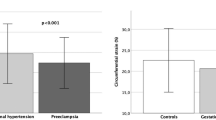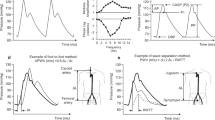Abstract
Preeclampsia is associated with a number of changes to maternal vascular function. Assessment of arterial stiffness using pulse wave analysis (PWA) has been proposed as a means of predicting preeclampsia before the onset of clinically detectable disease. One hundred and eighty women with ⩾2 risk factors for preeclampsia were examined at gestational weeks 16 and 28, of whom 17 (9.4%) developed preeclampsia. To study the effects of pregnancy itself women were also examined at 6–9 months post-natally; an additional 30 healthy non-pregnant women were also examined. PWA was performed using SphygmoCor; augmentation index (AIx), a marker of arterial wave reflection, was also measured using EndoPAT-2000. Women who developed preeclampsia were more likely to be overweight and had a higher brachial and central diastolic BP at gestational week 16 than those who remained normotensive. There was no difference in any parameter of arterial wave reflection between non-pregnant and pregnant women, nor between those who developed preeclampsia and those who remained normotensive, when examined at weeks 16 and 28 or post-natally. In this cohort of women with risk factors for preeclampsia, PWA did not provide additional information beyond brachial blood pressure and maternal risk factor profile about the risk of future development of preeclampsia.
This is a preview of subscription content, access via your institution
Access options
Subscribe to this journal
Receive 12 digital issues and online access to articles
$119.00 per year
only $9.92 per issue
Buy this article
- Purchase on Springer Link
- Instant access to full article PDF
Prices may be subject to local taxes which are calculated during checkout



Similar content being viewed by others
References
Conde-Agudelo A, Villar J, Lindheimer M . World Health Organization systematic review of screening tests for preeclampsia. Obstet Gynecol 2004; 104 (6): 1367–1391.
Nichols WW, Singh BM . Augmentation index as a measure of peripheral vascular disease state. Curr Opin Cardiol 2002; 17 (5): 543–551.
Weber T, Auer J, O'Rourke MF, Kvas E, Lassnig E, Berent R et al. Arterial stiffness, wave reflections, and the risk of coronary artery disease. Circulation 2004; 109 (2): 184–189.
Macedo ML, Luminoso D, Savvidou MD, McEniery CM, Nicolaides KH . Maternal wave reflections and arterial stiffness in normal pregnancy as assessed by applanation tonometry. Hypertension 2008; 51 (4): 1047–1051.
Smith SA, Morris JM, Gallery EDM . Methods of assessment of the arterial pulse wave in normal human pregnancy. Am J Obstet Gynecol 2004; 190 (2): 472–476.
Kaihura C, Savvidou MD, Anderson JM, McEniery CM, Nicolaides KH . Maternal arterial stiffness in pregnancies affected by preeclampsia. Am J Physiol Heart Circ Physiol 2009; 297 (2): H759–H764.
Hausvater A, Giannone T, Sandoval YH, Doonan RJ, Antonopoulos CN, Matsoukis IL et al. The association between preeclampsia and arterial stiffness. J Hypertens 2012; 30 (1): 17–33.
North RA, McCowan LM, Dekker GA, Poston L, Chan EH, Stewart AW et al. Clinical risk prediction for pre-eclampsia in nulliparous women: development of model in international prospective cohort. Br Med J 2011; 342: d1875.
Carty DM, Siwy J, Brennand JE, Zurbig P, Mullen W, Franke J et al. Urinary proteomics for prediction of preeclampsia. Hypertension 2011; 57 (3): 561–569.
Carty DM, Anderson LA, Duncan CN, Baird DP, Rooney LK, Dominiczak AF et al. Peripheral arterial tone: assessment of microcirculatory function in pregnancy. J Hypertens 2012; 30 (1): 117–123.
Duckitt K, Harrington D . Risk factors for pre-eclampsia at antenatal booking: systematic review of controlled studies. Br Med J 2005; 330 (7491): 565.
Brown MA, Lindheimer MD, De Swiet M, Van Assche A, Moutquin JM . The classification and diagnosis of the hypertensive disorders of pregnancy: statement from the International Society for the Study of Hypertension in Pregnancy (ISSHP). Hypertens Pregnancy 2001; 20 (1): IX–XIV.
Wilkinson IB, Fuchs SA, Jansen IM, Spratt JC, Murray GD, Cockcroft JR et al. Reproducibility of pulse wave velocity and augmentation index measured by pulse wave analysis. J Hypertens 1998; 16 (12 Pt 2): 2079–2084.
Ronnback M, Lampinen K, Groop PH, Kaaja R . Pulse wave reflection in currently and previously preeclamptic women. Hypertens Pregnancy 2005; 24 (2): 171–180.
Khalil AA, Cooper DJ, Harrington KF . Pulse wave analysis: a preliminary study of a novel technique for the prediction of pre-eclampsia. Br J Obstet Gynaecol 2009; 116 (2): 268–276.
Redman CW, Sargent IL . Placental stress and pre-eclampsia: a revised view. Placenta 2009; 30 (Suppl A): S38–S42.
Khalil A, Jauniaux E, Cooper D, Harrington K . Pulse wave analysis in normal pregnancy: a prospective longitudinal study. Plos One 2009; 4 (7): e6134.
Robb AO, Mills NL, Din JN, Smith IBJ, Paterson F, Newby DE et al. Influence of the menstrual cycle, pregnancy, and preeclampsia on arterial stiffness. Hypertension 2009; 53 (6): 952–U115.
Macgillivray I, Rose GA, Rowe B . Blood pressure survey in pregnancy. Clin Sci 1969; 37 (2): 395–407.
Helewa ME, Burrows RF, Smith J, Williams K, Brain P, Rabkin SW . Report of the Canadian Hypertension Society Consensus Conference: 1. Definitions, evaluation and classification of hypertensive disorders in pregnancy. Can Med Assoc J 1997; 157 (6): 715–725.
Nama V, Antonios TF, Onwude J, Manyonda IT . Mid-trimester blood pressure drop in normal pregnancy: myth or reality? J Hypertens 2011; 29 (4): 763–768.
Acknowledgements
We would like to thank all the pregnant women who participated in the study, as well as the clinic midwives and the research nursing team of the Glasgow Clinical Research Facility. The study was funded by a Strategic Research Development grant “Biomarkers for Battling Chronic Disease” from the Scottish Funding Council and a project grant (reference ETM/196) from the Chief Scientist Office of the Scottish Government.
Author information
Authors and Affiliations
Corresponding author
Ethics declarations
Competing interests
The authors declare no conflict of interest
Additional information
Supplementary Information accompanies this paper on the Journal of Human Hypertension website
Supplementary information
Rights and permissions
About this article
Cite this article
Carty, D., Neisius, U., Rooney, L. et al. Pulse wave analysis for the prediction of preeclampsia. J Hum Hypertens 28, 98–104 (2014). https://doi.org/10.1038/jhh.2013.64
Received:
Revised:
Accepted:
Published:
Issue Date:
DOI: https://doi.org/10.1038/jhh.2013.64
Keywords
This article is cited by
-
Wave intensity analysis of maternal arterial stiffness: augmentation index and pulse wave velocity in pregnancies complicated by diabetes or hypertension
Archives of Gynecology and Obstetrics (2020)
-
Non-invasive pulse wave analysis for monitoring the cardiovascular effects of CO2pneumoperitoneum during laparoscopic cholecystectomy- a prospective case-series study
BMC Anesthesiology (2014)
-
The use of pulse wave velocity in predicting pre-eclampsia in high-risk women
Hypertension Research (2014)



